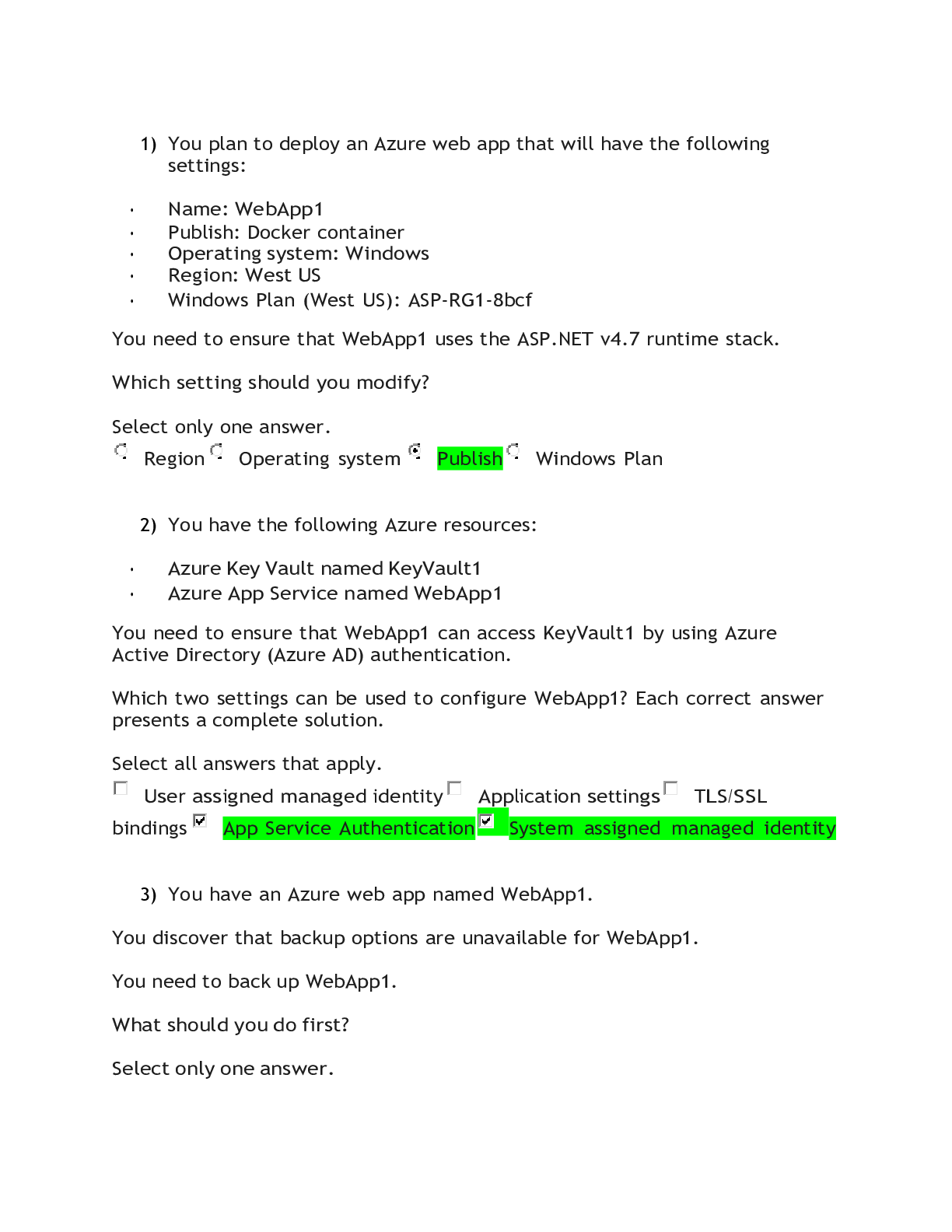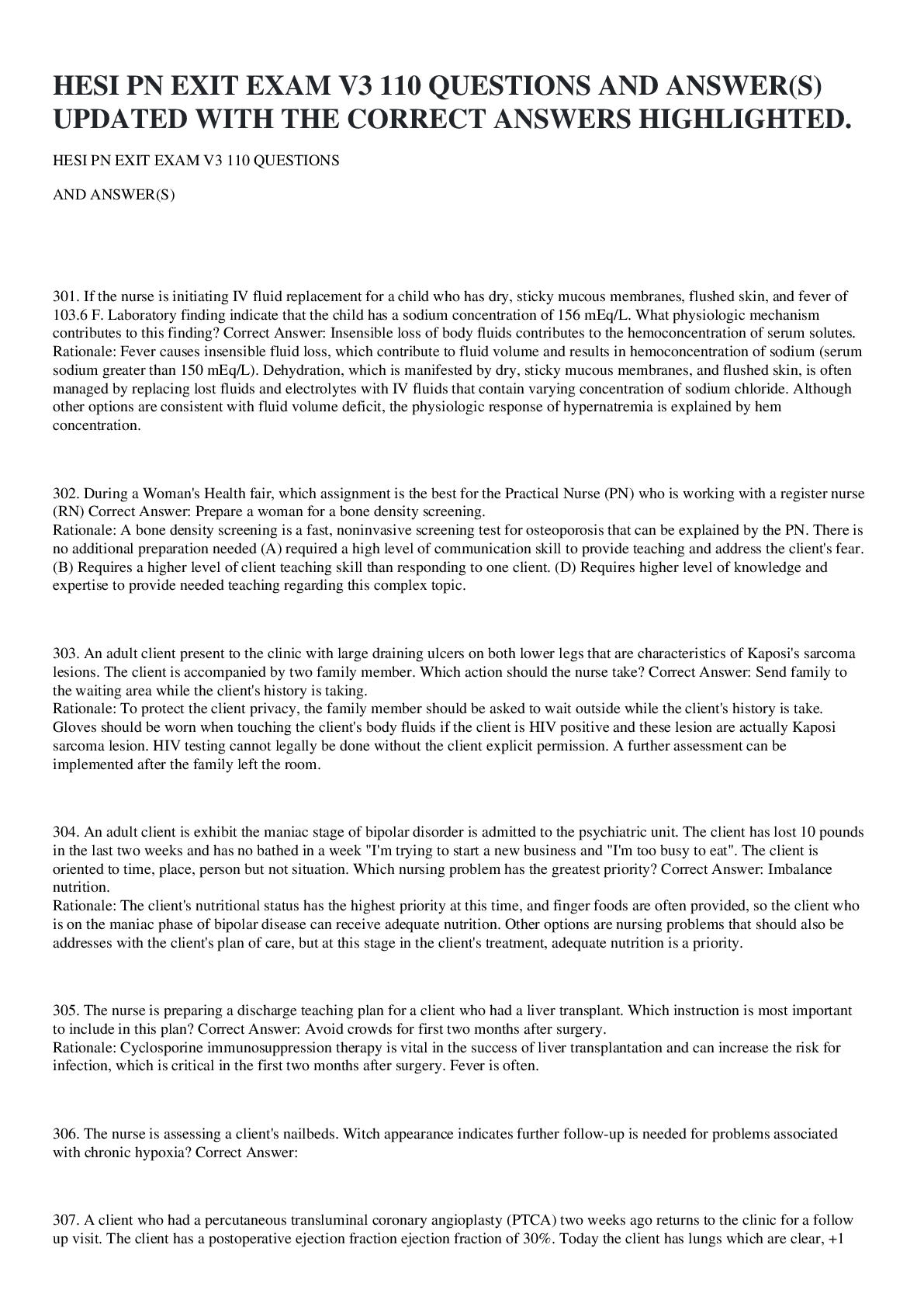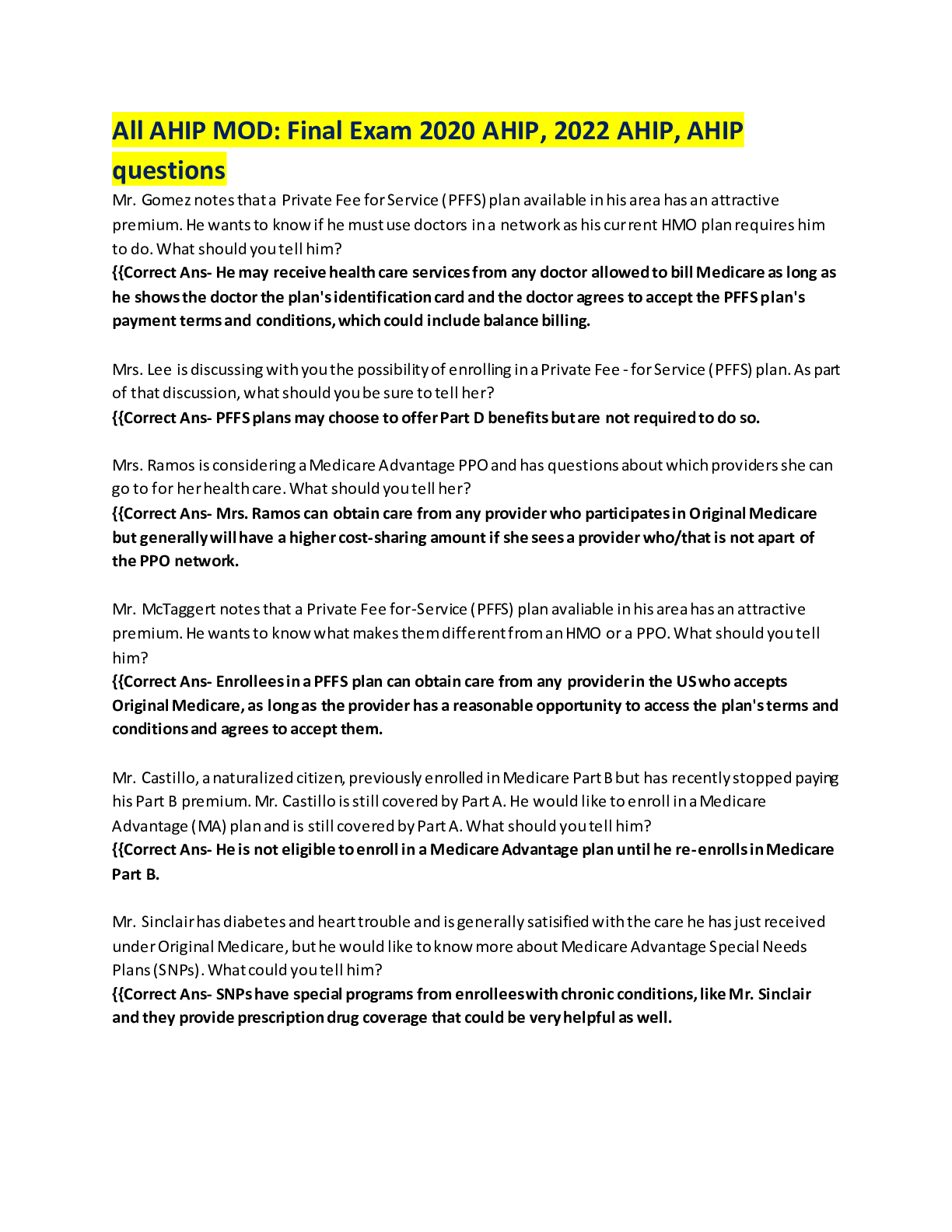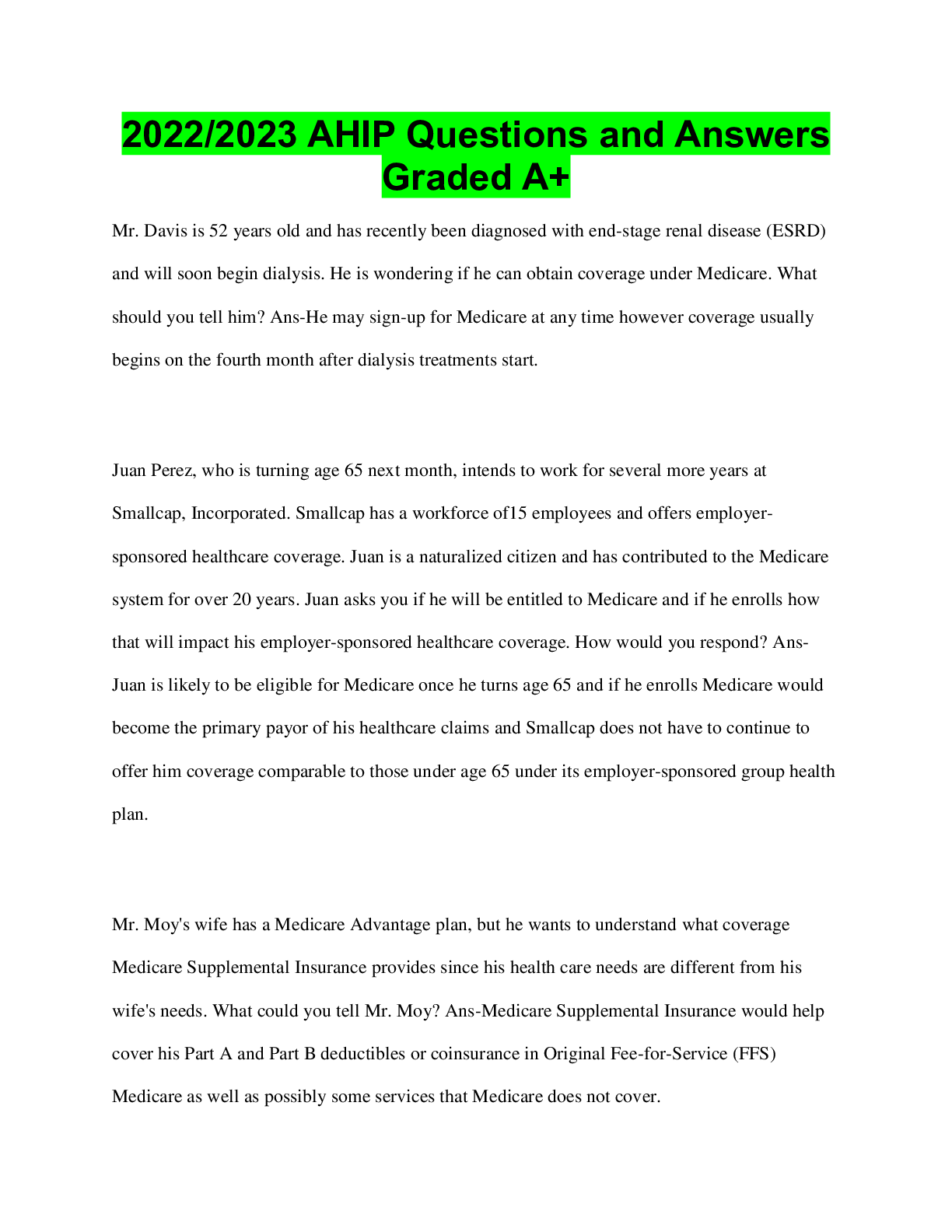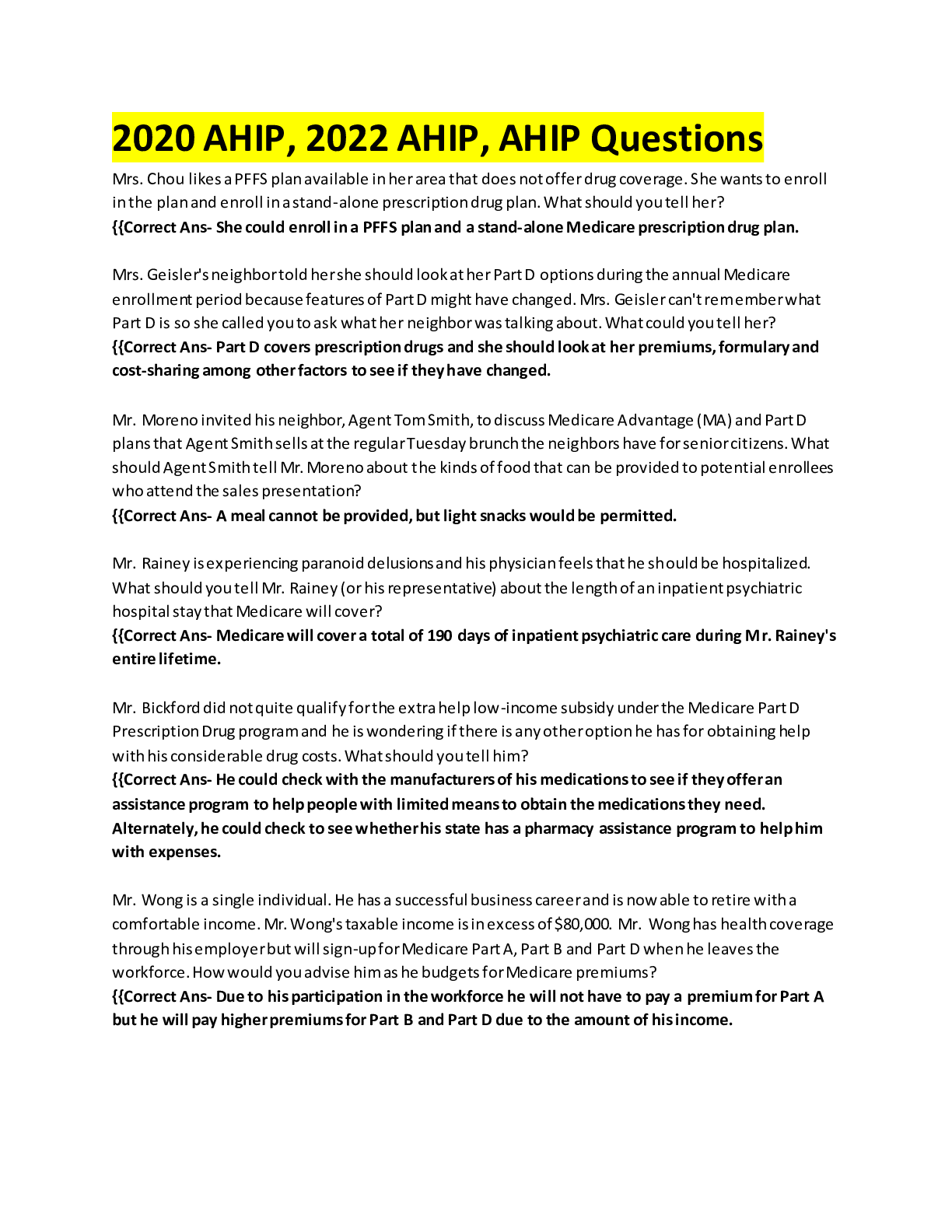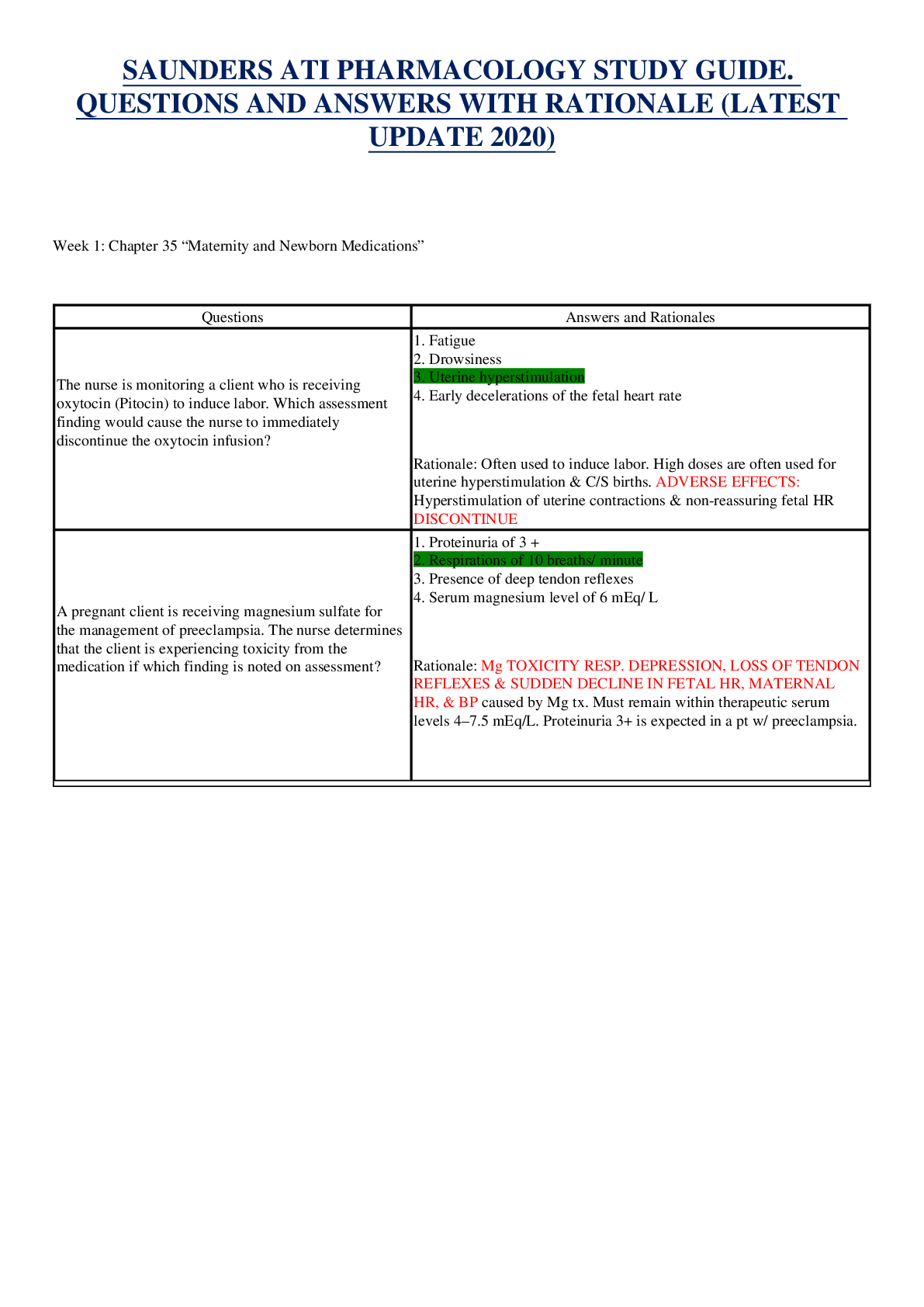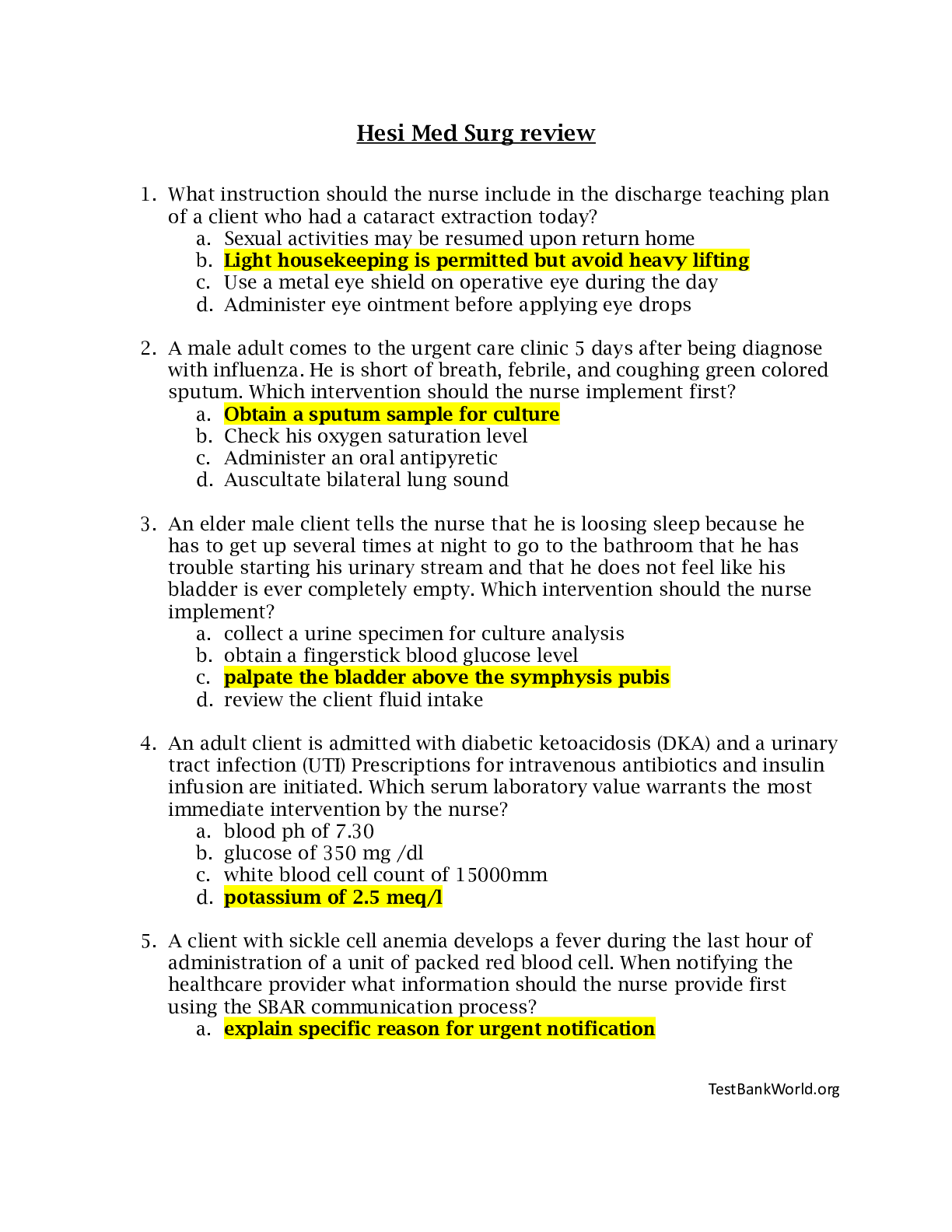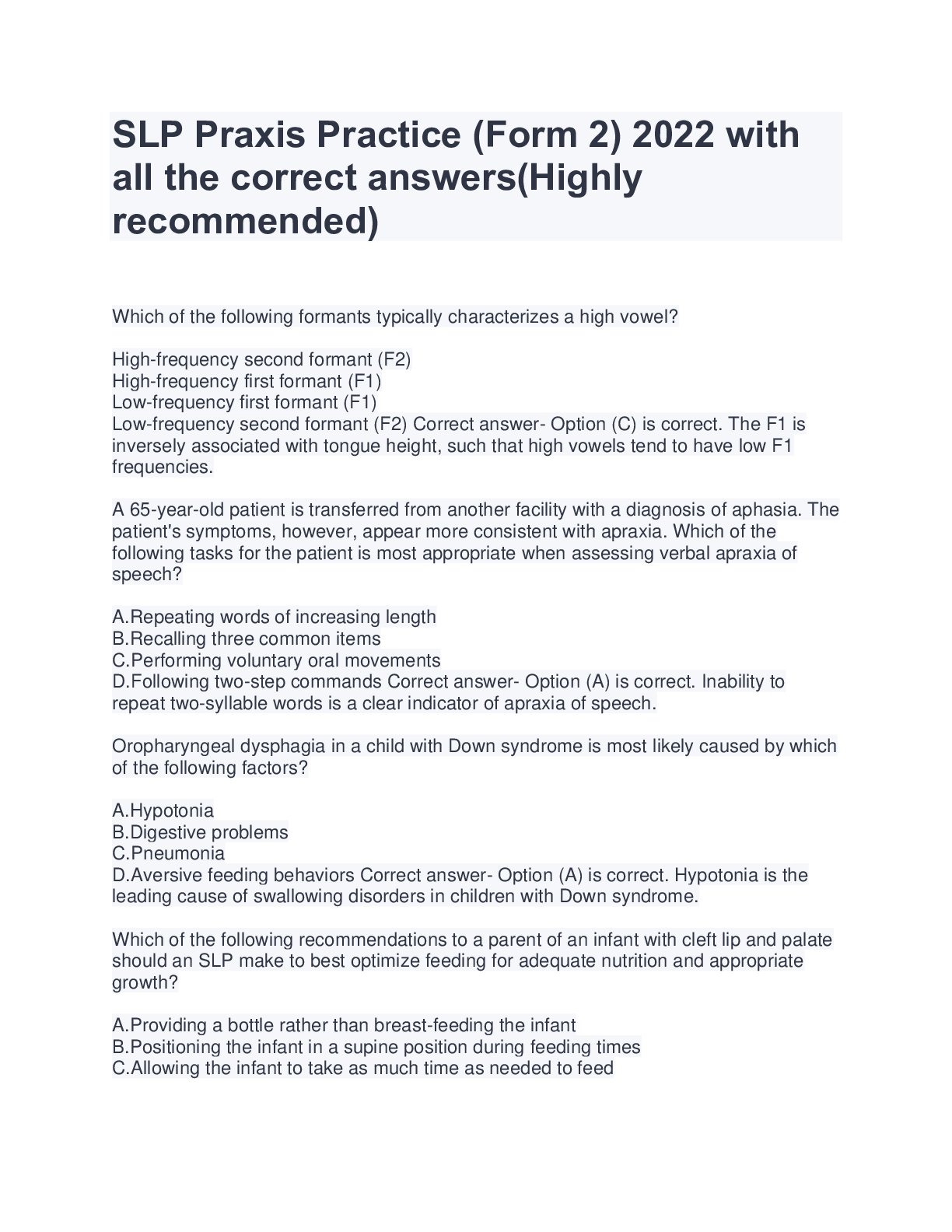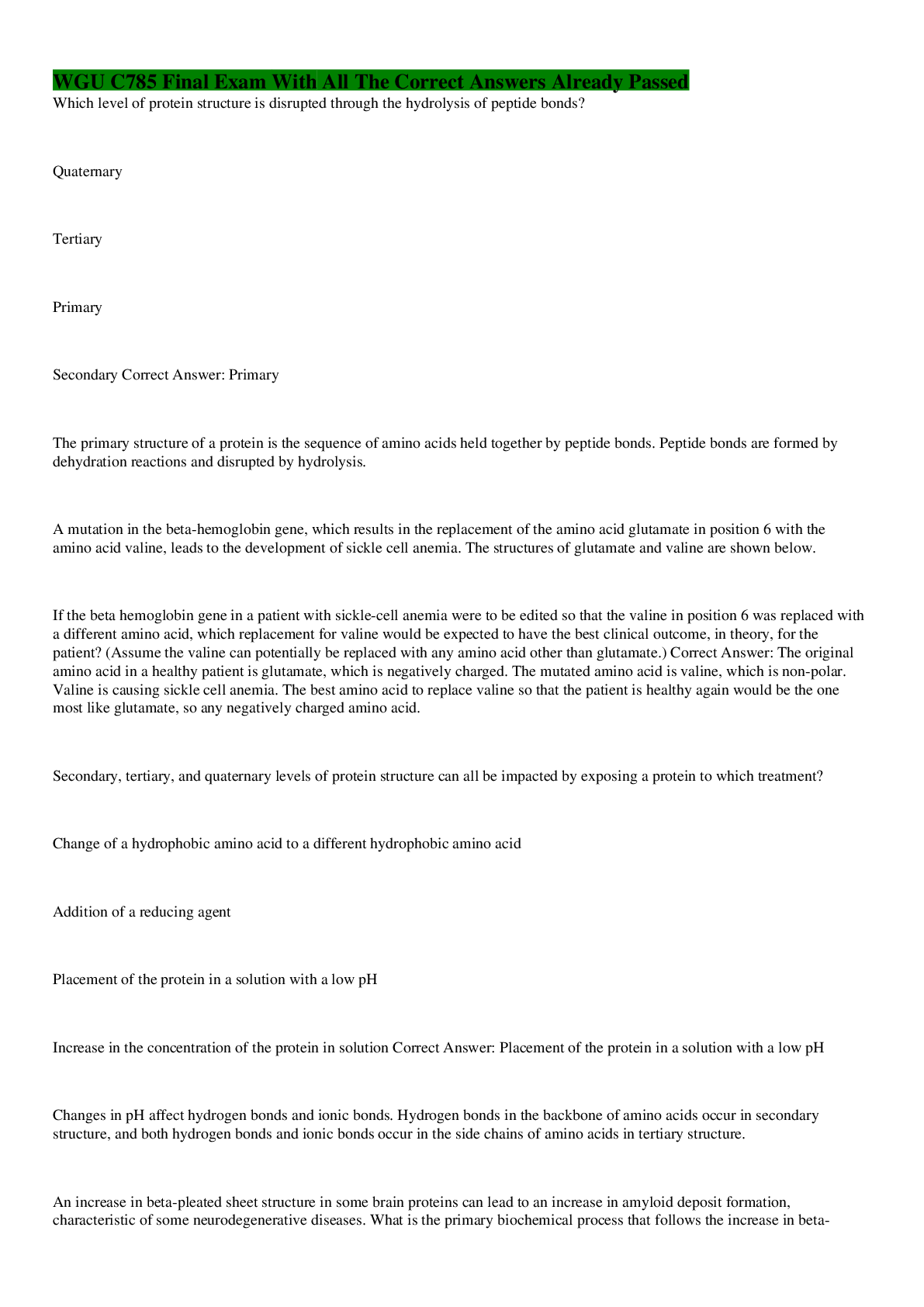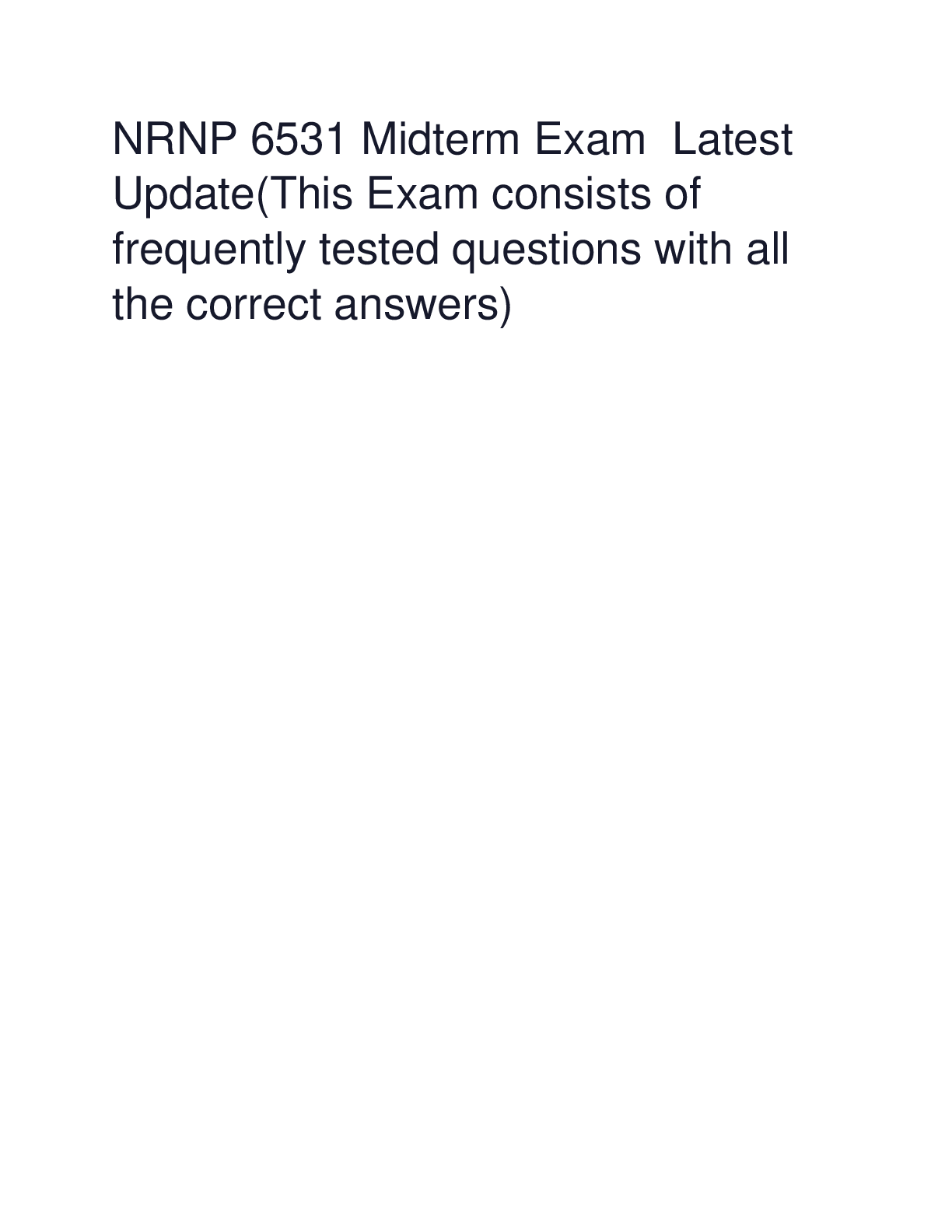OB Hesi questions with all the correct answers latest update 2020
Document Content and Description Below
OB Hesi questions with all the correct answers 1. A primipara has delivered a stillborn fetus at 30-weeks gestation. To assist the parents with the grieving process, which intervention is most import... ant for the nurse to implement? 2. A one-day-old neonate develops a cephalhematoma. The nurse should closely assess this neonate for which common complication? 3. What is the most important assessment for the nurse to conduct following the administration of epidural anesthesia to a client who is at 40-weeks gestation? KNOW TYPES OF ANESTHESIA 4. The nurse is caring for a female client, a primigravida, with preeclampsia. Findings include +2 proteinuria, BP 172/112 mmHg, facial and hand swelling, complaints of blurry vision and a severe frontal headache. Which medication should the nurse anticipate for this client? 6. A client at 35 weeks gestation complains of a “pain whenever the baby moves.” On assessment, the nurse notes the client’s temperature to be 101.2 F, with severe abdominal or uterine tenderness on palpation. The nurse knows that these findings are indicative of what condition? 7. While caring for a laboring client on continuous fetal monitoring, the nurse notes a fetal heart rate pattern that falls and rises abruptly with a “v” shaped appearance. What action should the nurse take first? 8. The parents of a newborn tell the nurse that their newborn is already trying to walk. How should the nurse respond? 9. The nurse is conducting postpartum teaching with a mother who is breastfeeding her infant. When discussing birth control, which method should the nurse recommend to this client as best for her to use in preventing an unwanted pregnancy? 10. The nurse is planning discharge teaching for a client who had an evacuation of gestational trophoblastic disease (GTD) two days ago. Which information is most important for the nurse to include in this client’s teaching plan? 11. The nurse places one hand above the symphysis while massaging the fundus of a multiparous client whose uterine tone is boggy 15 minutes after delivering a 7 pound 10 ounce infant. Which information should the nurse provide the client about this finding? 12. A primigravida arrives at the observation unit of the maternity unit because thinks is in labor. The nurse applies the external fetal heart monitor and determines that the fetal heart rate is 140 beats/minute and the contractions are occurring irregularly every 10 to 15 minutes. What assessment finding confirms to the nurse that the client is not labor at this time? 13. A client delivers a viable infant, but begins to have excessive uncontrolled vaginal bleeding after the IV Pitocin is infused. When notifying the healthcare provider of the client’s condition, what information is most important for the nurse to provide? 14. The current vital signs for a primipara who delivered vaginally during the previous shift are: temperature 100.4 F, heart rate 58 beats/minute, respiratory rate 16 breaths/minute, and blood pressure 130/74. What action should the nurse implement? 15. A 4-day postpartum client calls the clinic and reports that her nipples are so sore that she does not know if she can continue to breastfeed her infant. What instruction is best for the nurse to provide? 16. An infant is placed in a radiant warmer immediately after birth. At one hour of age, the nurse finds the infant to be jittery, tachypneic, and hypotonic. What is the first action that the nurse should take? 17. A 36-week primigravida is admitted to labor and delivery with severe abdominal pain and bright red vaginal bleeding. Her abdomen is rigid and tender to touch. The fetal heart rate (FHR) is 90 beats/minute, and the maternal heart rate is 120 beats/minute. What action should the nurse implement first? 18. A client whose labor is being augmented with an oxytocin (Pitocin) infusion requests an epidural for pain control. Findings of the last vaginal exam, performed 1 hour ago, were 3 cm cervical dilatation, 60% effacement, and a -2 station. What action should the nurse implement first? 19. The nurse is assessing a 38-week gestation newborn infant immediately following a vaginal birth. Which assessment finding best indicates that the infant is transitioning well to extrauterine life? 20. What goal is most important for the nurse to include in the plan of care for a client with gestational diabetes? MATH: Two questions she thinks one answer was 42 She thinks other math question was this: A 34-week primigravida woman with preeclampsia is receiving lactated ringer’s 500 mL with magnesium sulfate 20 grams at the rate of 3 grams/hour. How many mL/hr should the nurse program the infusion pump? QUESTION SHE COULD REMEMBER ANSWER BUT NOT QUESTION: something about what patient do you see first? A couple questions on diabetes IDK? Mag sulfate toxicity s/s? Everything slows down/things are absent- Absent DTR, muscle weakness, cardiac arrest, resp depression, CNS depression, blurred vision, slurred speech, sweating, hypotension Signs and symptoms of mastitis and treatment : Common upper out quadrant unilaterally Mastitis – infection in breast • Signs – painful or tender localized hard mass and reddened area usually on one breast; flu-like symptoms like chill and fatigue Education on breast hygiene for prevention – wash hands prior to breastfeeding, keep breast clean, allow nipples to air dry, when breastfeeding – make sure baby has entire nipple and areola not just nipple, have breast be emptied during each feeding Nutritional needs of 16 year old pregnant The diets of teenagers before pregnancy are often low in vitamin A, folic acid, calcium, iron, and zinc. Although they may get 3 or 4 servings of vegetables daily, 1 or 2 may be potatoes, often French fries. Girls average only 1.5 servings of fruits and dairy a day. Foods high in sugar and fat are common (Nichols-Richardson, 2011b). These habits often lead to inadequate stores of these nutrients for pregnancy. Supplements may be prescribed, but the adolescent may not take them regularly. This combination of poor intake and unreliable supplementation may further deplete nutrient stores and general nutritional status. Adolescents are often concerned about body image. If weight is a major focus for a teenager and her peers, she is more likely to restrict calories to prevent weight gain during pregnancy. Teenagers tend to skip meals, especially breakfast. The fetus requires a steady supply of nutrients, and the expectant mother's stores may be used if intake is not sufficient to meet fetal needs. Teenagers are often in a hurry and want foods that are fast and convenient. Meals may be irregular and often eaten away from home. A significant part of the adolescent diet may consist of fast foods from restaurants or snack machines. These foods are often high in fat, sweeteners, and sodium and low in vitamins, minerals, and fiber. Peer pressure is an important influence on nutritional status. Choosing fast foods that do not make her appear different from her peers yet meet her added nutrient needs is important for the pregnant adolescent. Chorioamnionitis- What will you do for this? The nurse's responsibility is to report findings promptly to the primary health care provider and to document findings in the labor record and on the monitor strip (if that is agency policy). If abnormal findings are noted, continuous electronic monitoring is usually initiated and maintained for the duration of labor. The presence of meconium-stained amniotic fluid alerts the nurse of the need to observe fetal status more closely. After birth, the newborn may be at high risk for alteration in respiratory status if meconium is aspirated into the lungs with the first breath. MAYBE QUESTIONS? A laboring client’s membranes rupture spontaneously. The nurse notices that the amniotic fluid is greenish-brown. What intervention should the nurse implement first? Artificial rupture of the membranes of a laboring client reveals meconium-stained fluid. What intervention has the greatest priority? Signs of Potential Complications Labor • Intrauterine pressure of more than 75 mm Hg (determined by intrauterine pressure catheter monitoring) or resting tone of more than 15 mm Hg • Contractions consistently lasting 90 seconds or more • Contractions consistently occurring 2 minutes or less apart • Fetal bradycardia, tachycardia, or persistently decreased variability • Irregular FHR; suspected fetal dysrhythmias • Appearance of meconium-stained or bloody fluid from the vagina • Arrest in progress of cervical dilation or effacement, descent of the fetus, or both • Maternal temperature of 38° C or more • Foul-smelling vaginal discharge • Persistent bright-red or dark-red vaginal bleeding Presumptive/probable/positive signs: Presumptive- amenorrhea, n/v, increase size/tenderness in breasts, pronounced nipples, urinary frequency, quickening (woman thinks she feels movements), fatigue Probable: uterine enlargement, Hegar sign (softening of uterus), Chadwicks sign (blueish color cervix), Goodells sign (softening of cervical cap), ballottement (rebound fetus), positive test with hcg Positive: FHR, active fetal movements palpable by examiner, outline of fetus on US [Show More]
Last updated: 1 year ago
Preview 1 out of 6 pages
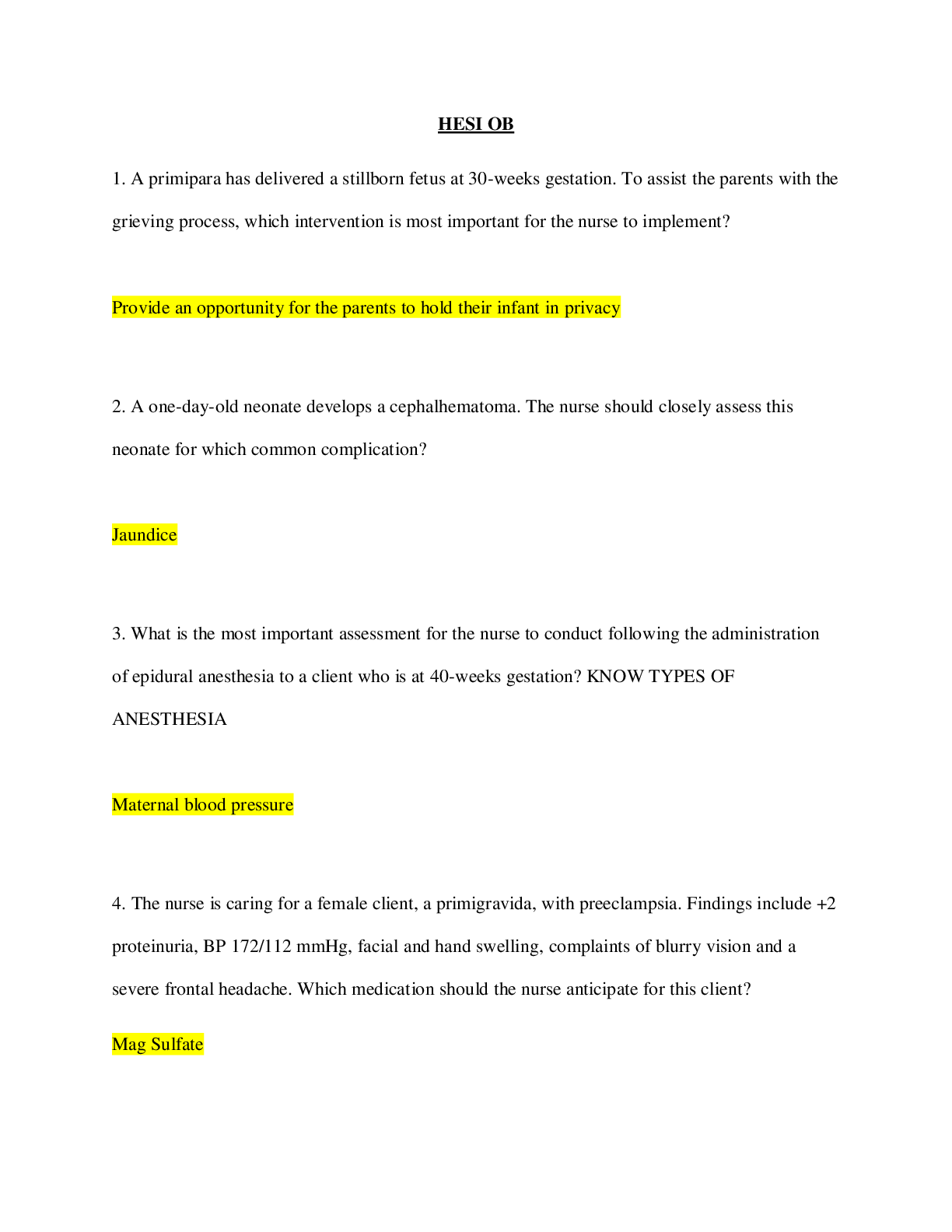
Reviews( 0 )
Document information
Connected school, study & course
About the document
Uploaded On
Dec 24, 2020
Number of pages
6
Written in
Additional information
This document has been written for:
Uploaded
Dec 24, 2020
Downloads
0
Views
76


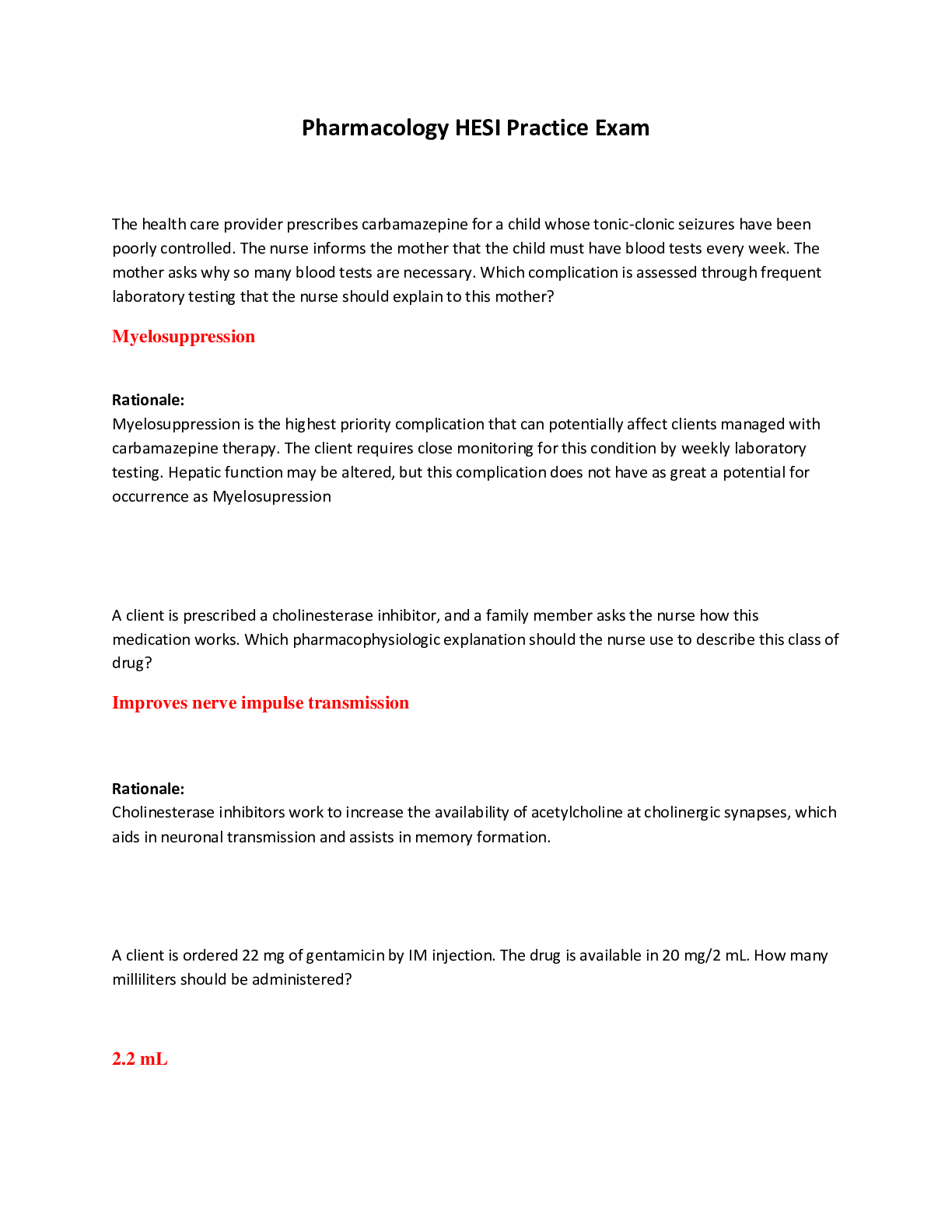
.png)
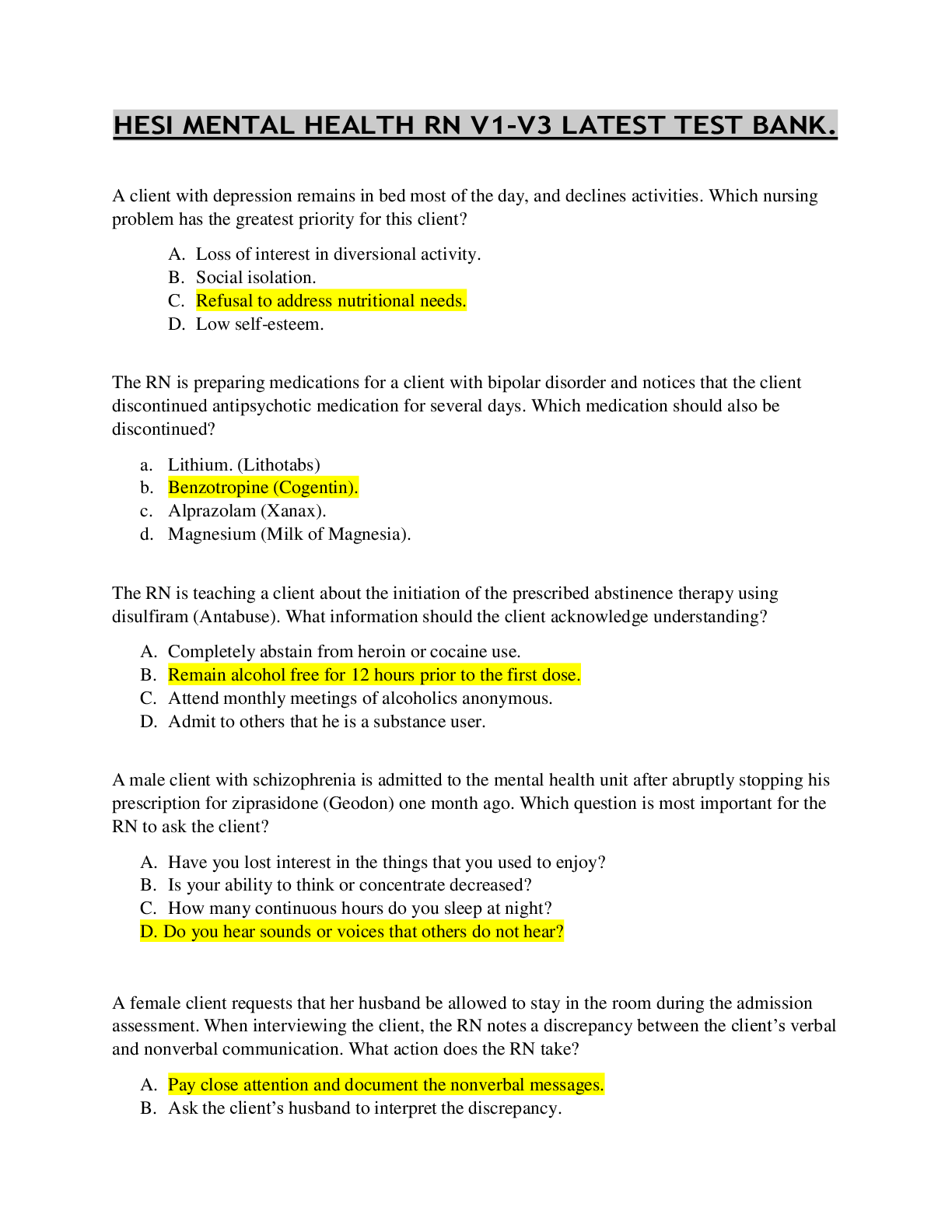

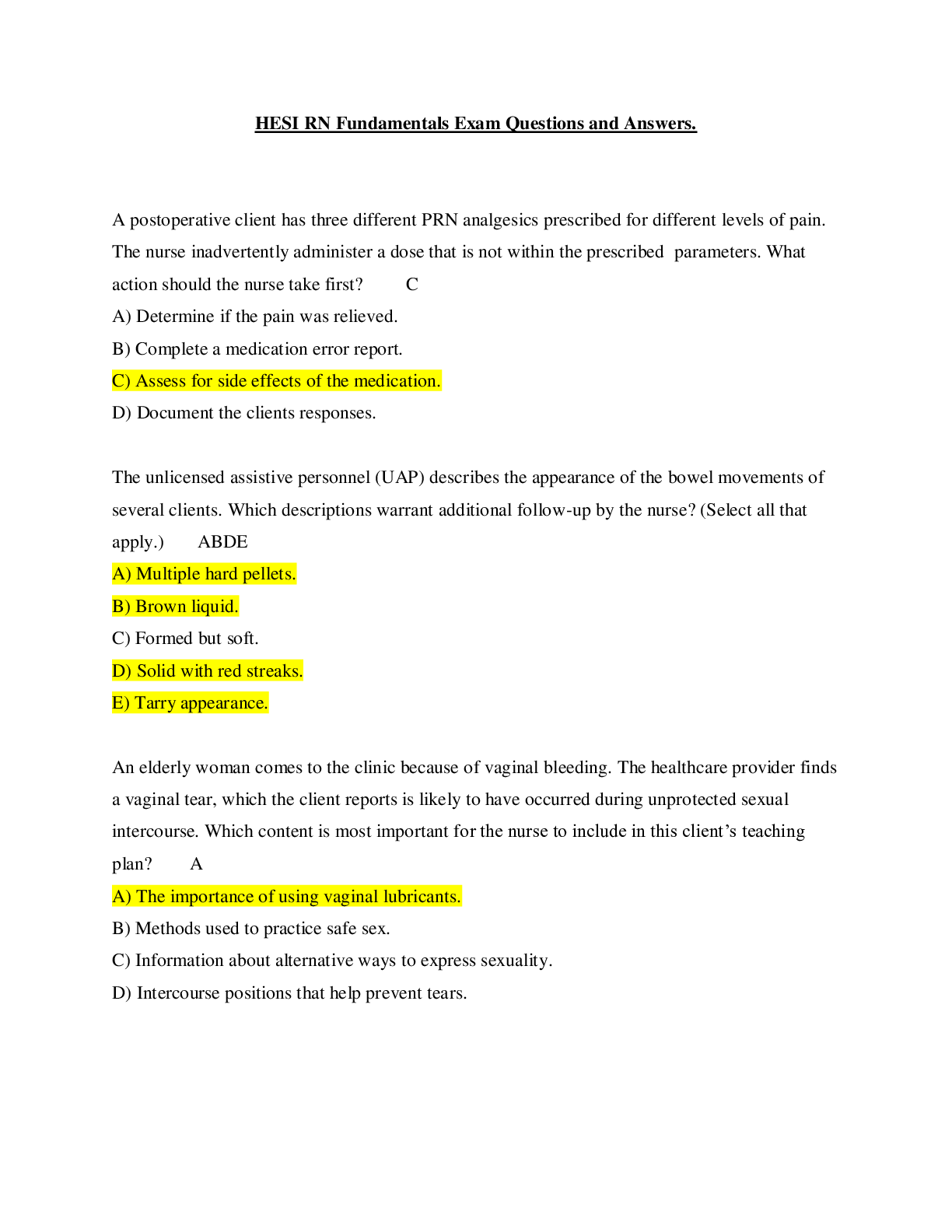
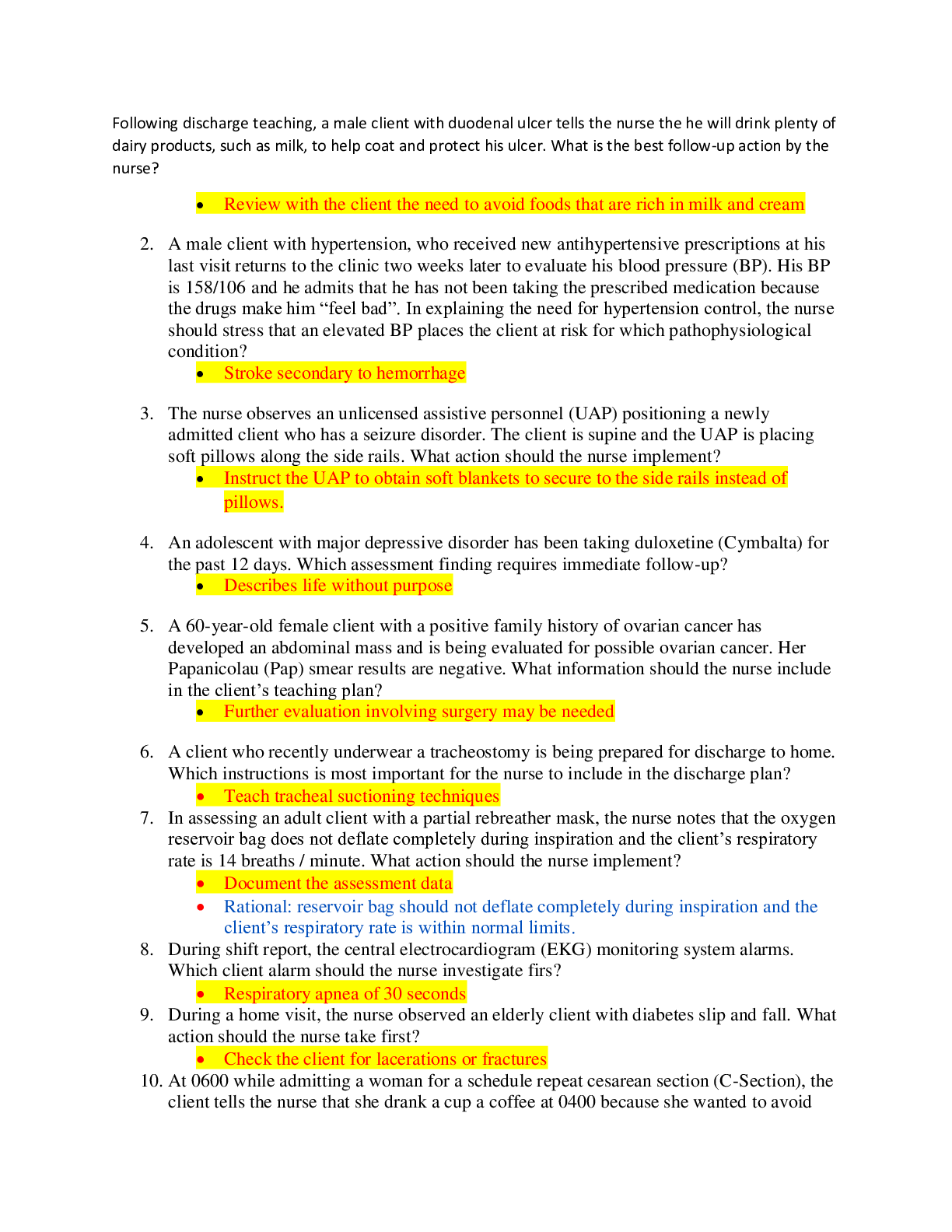
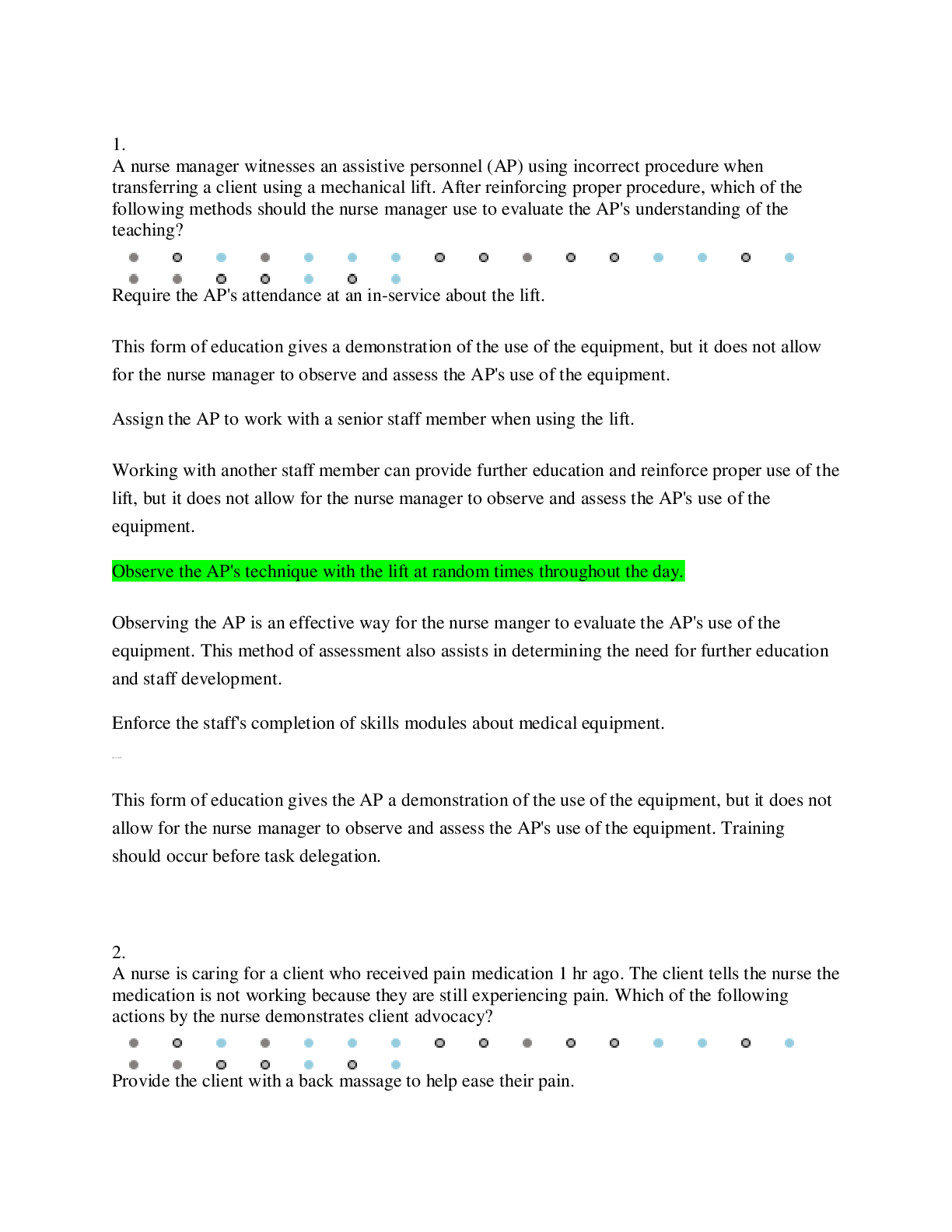
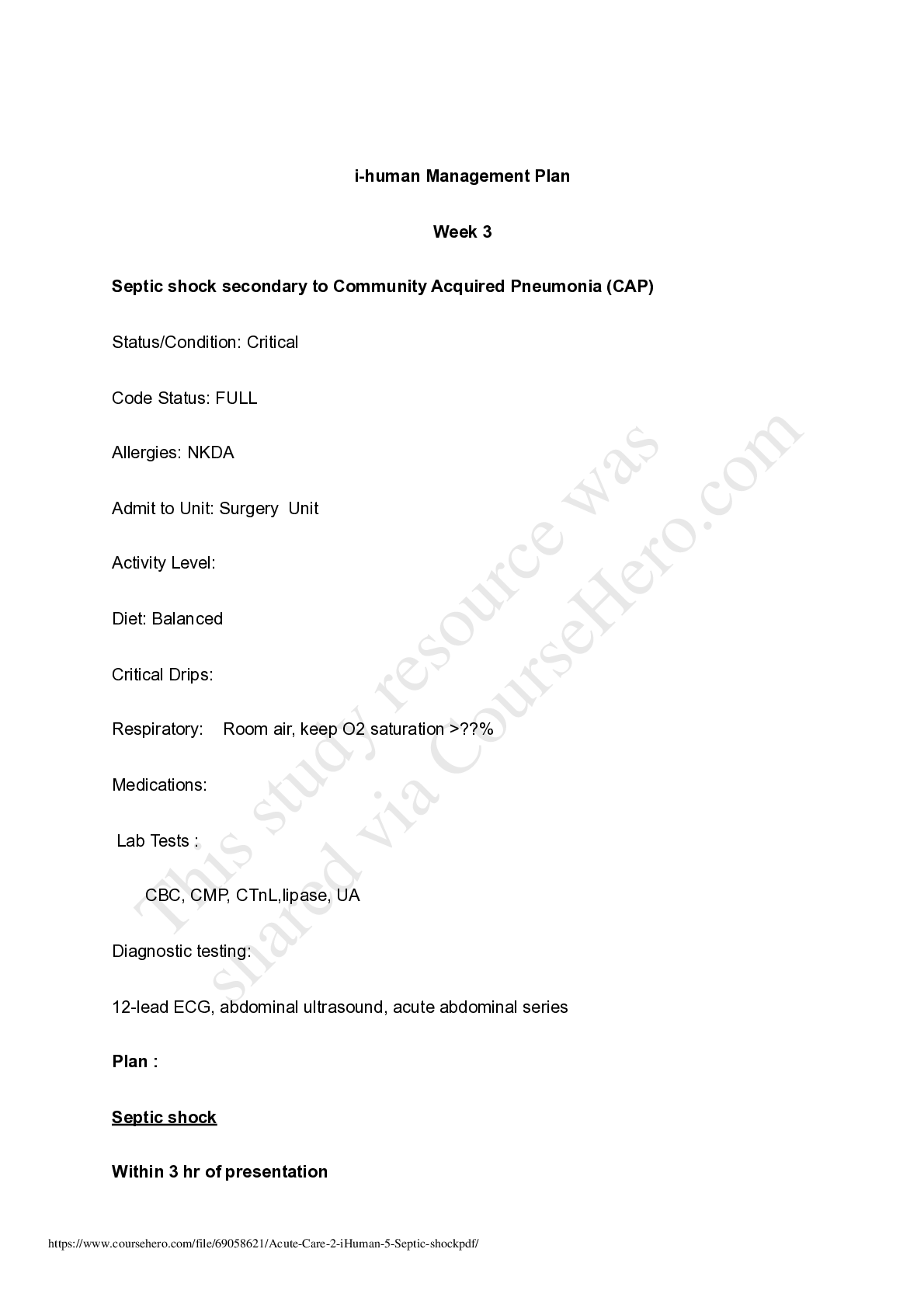
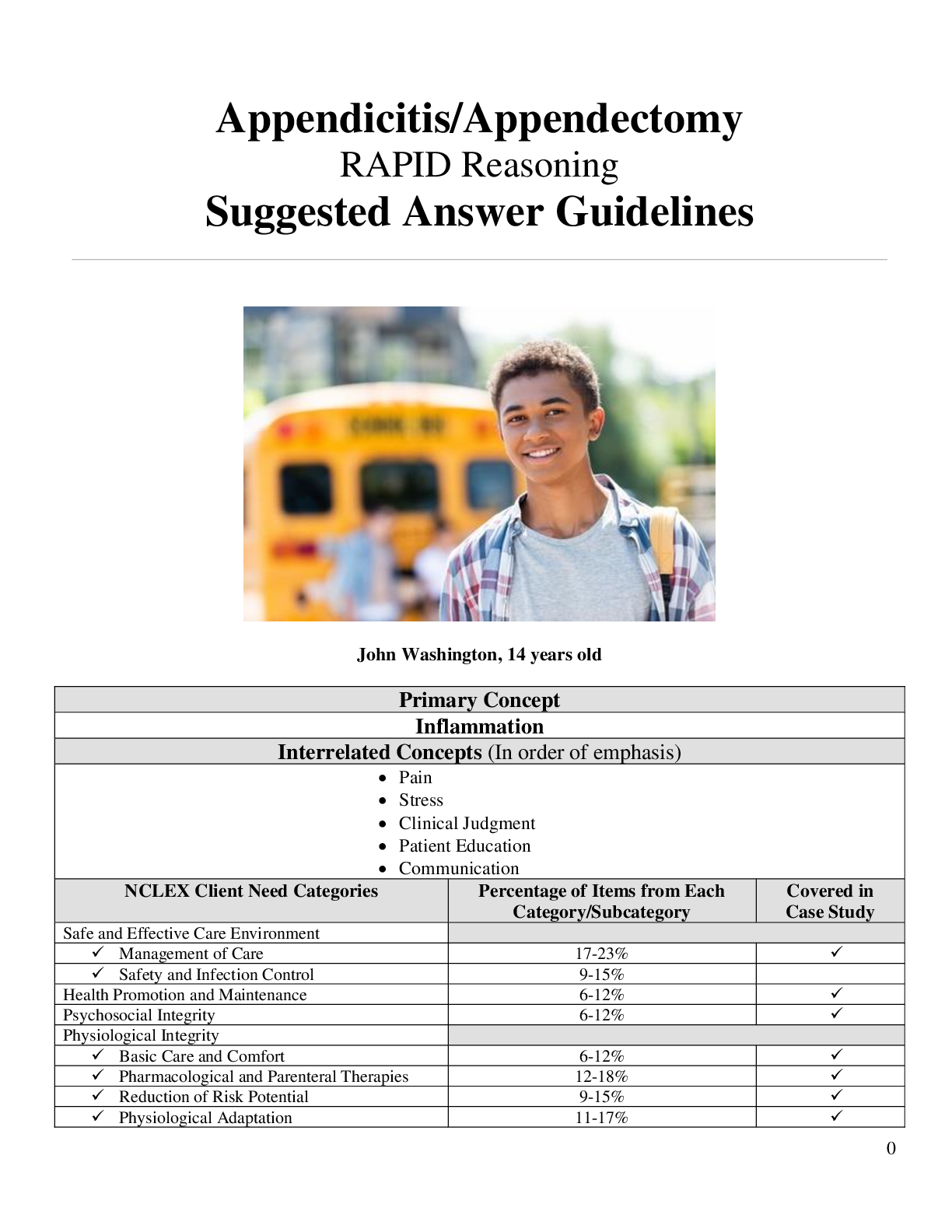
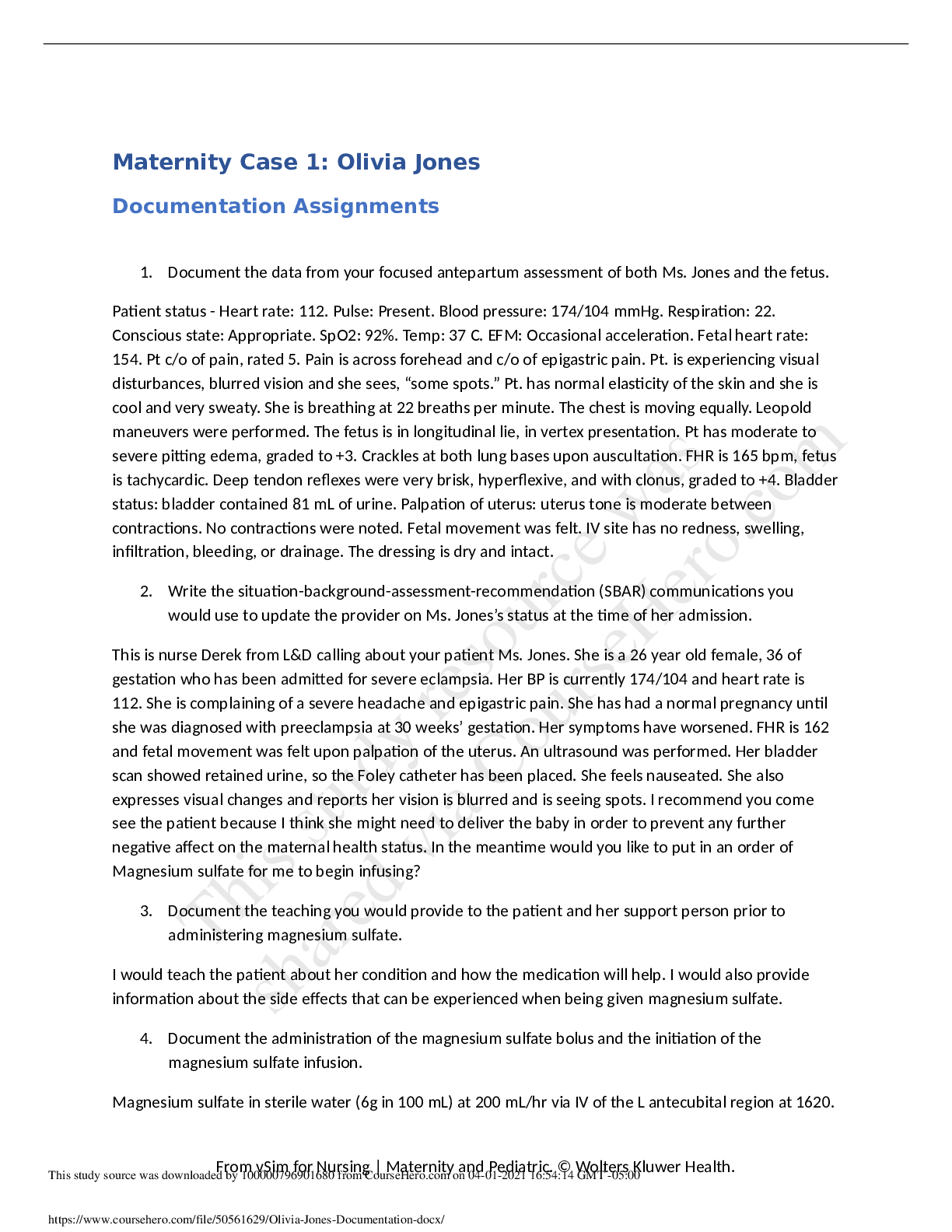
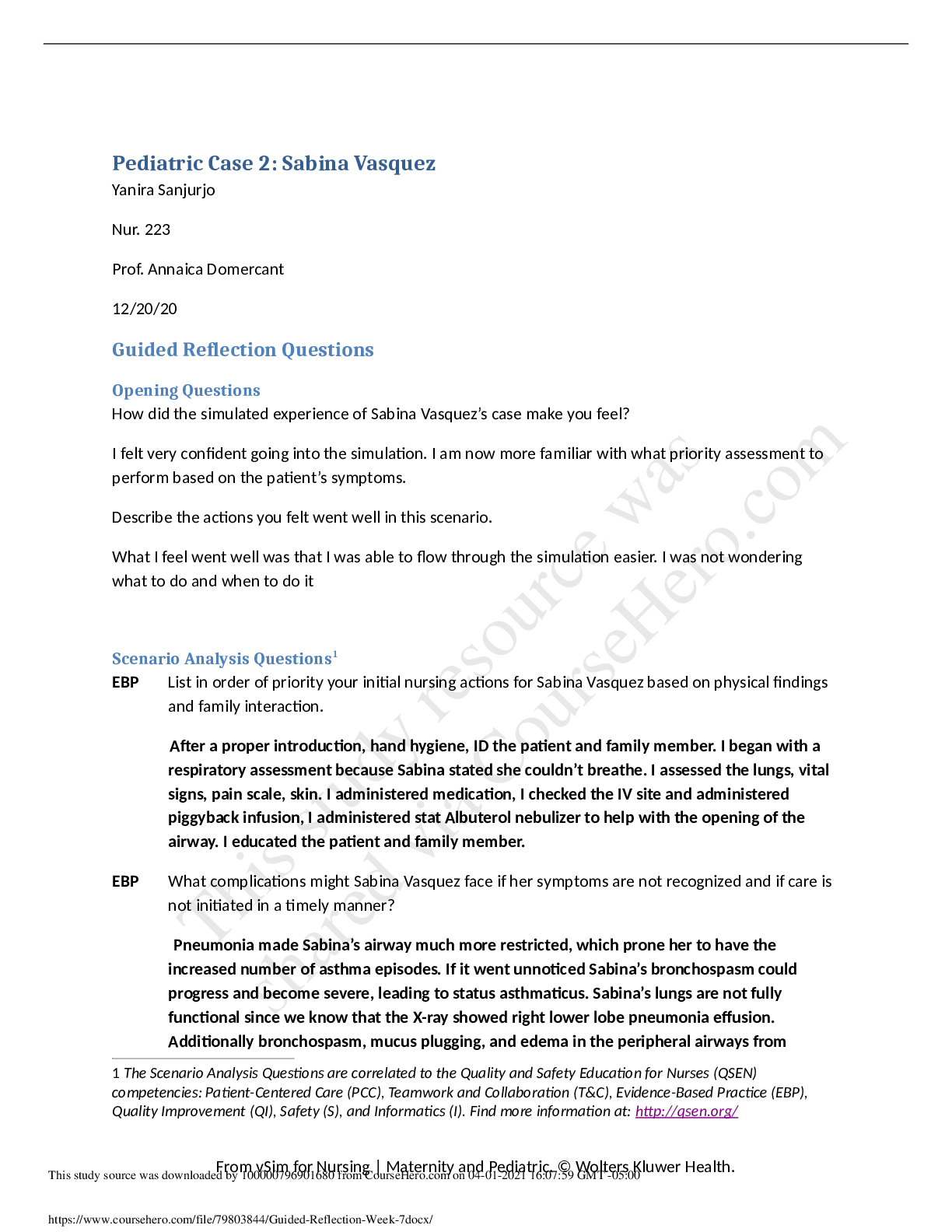
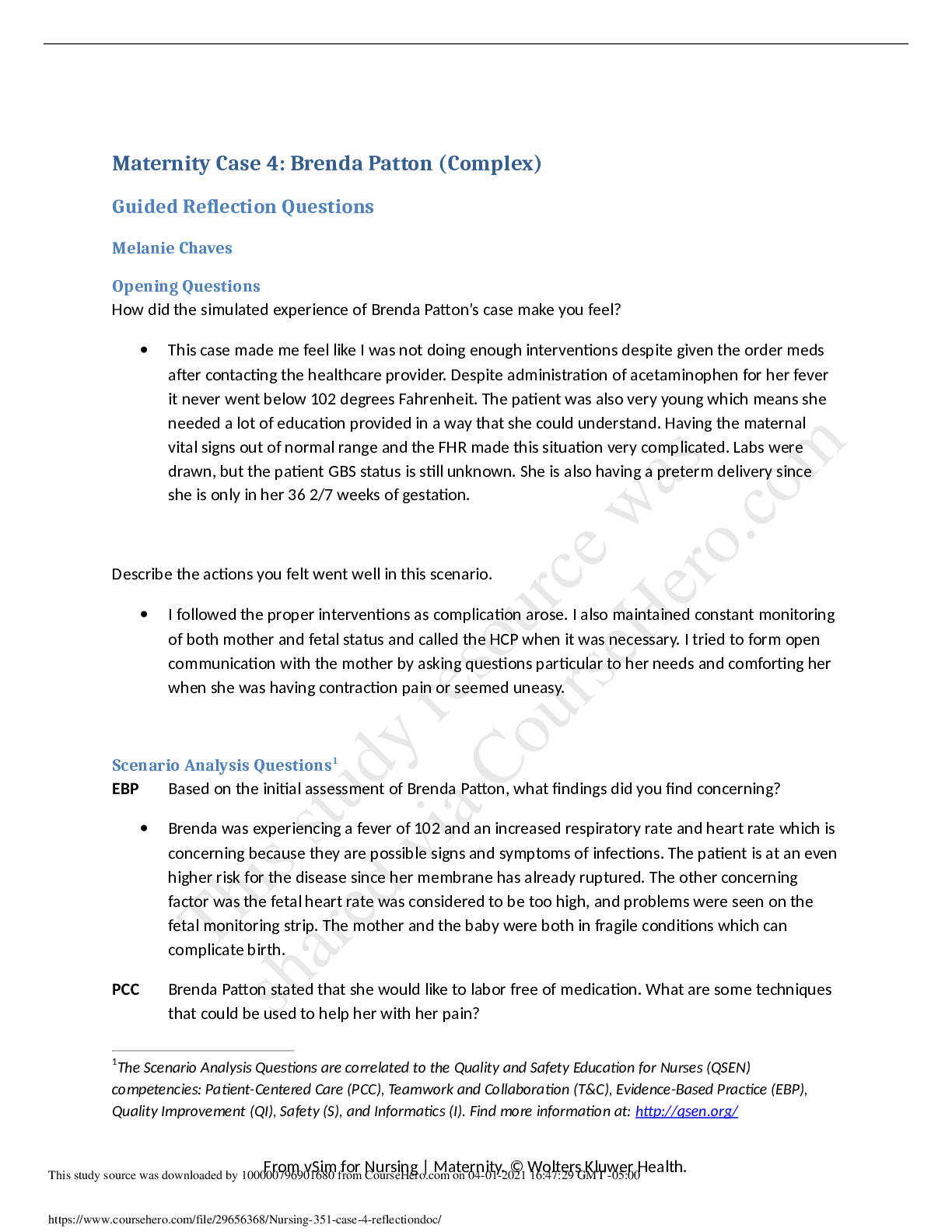


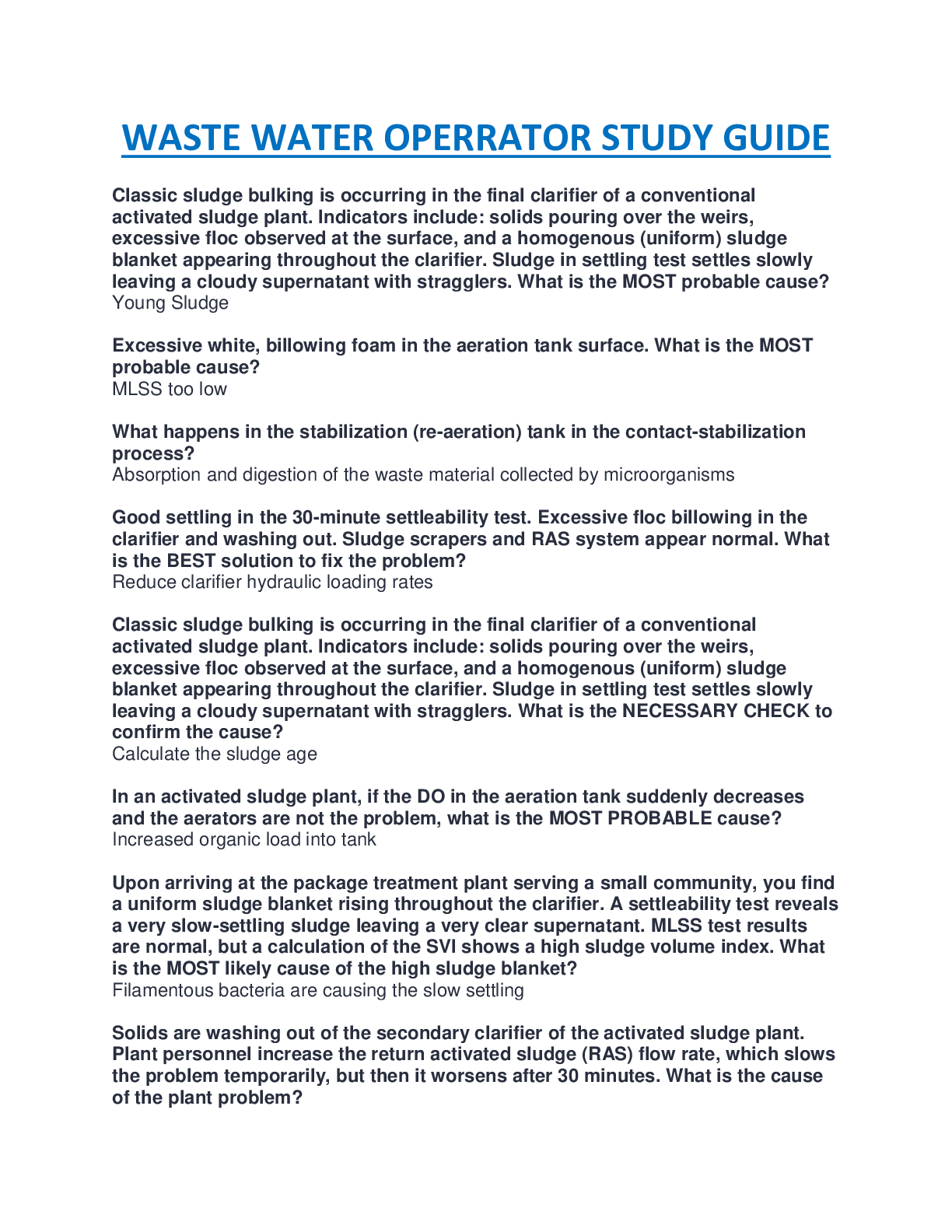
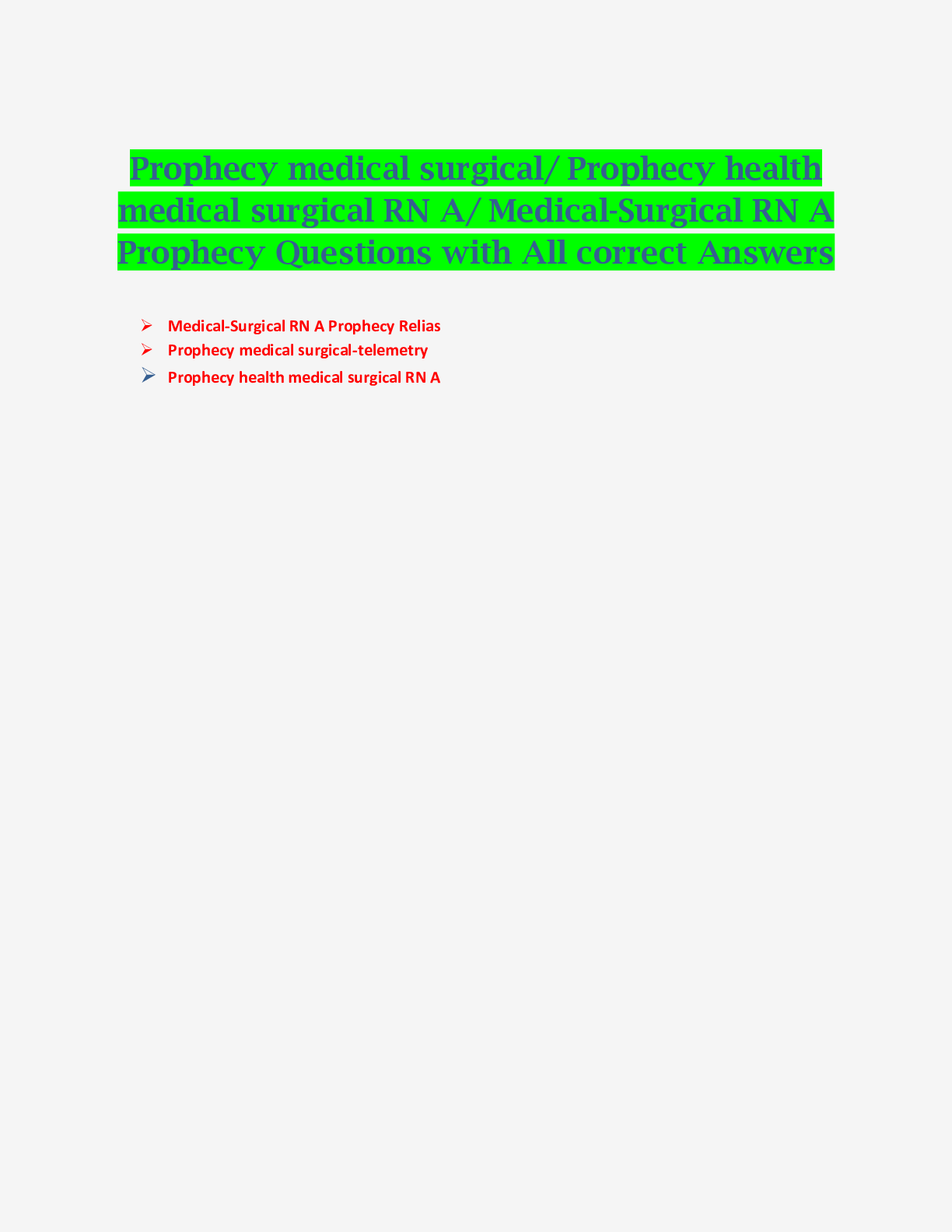
.png)

.png)
